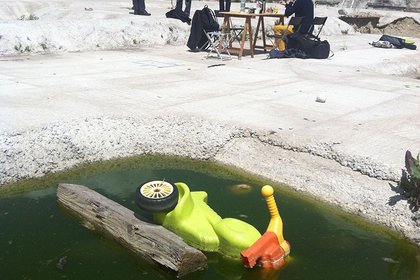
'Mi.ZA' MAKES COFFEE
Format Action
City Maribor, Slovenia

'Mi.ZA' Makes Coffee was first organised by a small interest society of architects in Maribor, abbreviated as Mi.ZA (‘miza’ also means ‘table’ in Slovenian, so the title of the tool sounds like ‘table makes coffee’, whereas ‘mi za’ would mean ‘we for’). As there were many unfinished projects and degraded areas in Maribor, and there was a need to publicly expose them, a small group of people decided to organize unusual meetings at the locations themselves. One of the first locations selected was a huge unfinished building project in the center of Maribor, where only the foundations had been built. In order to bring attention to this site, a coffee-making meeting was organized around a small table. Even the media were present. The meeting provided a serious thematic discussion as well as a informal encounter between people.

Location Find a problematic location
Undoubtedly, there are plenty of sites in your neighbourhood or city that require more attention and critical discussion. Select those locations that are interesting for their significant spatial, political or social problematic. Think of unfinished building projects, places with a dubious background or history, or particular public spaces with evident problems. The location that you want to address is the point of departure for this tool; you probably already have somewhere in mind!
Communication Invite
First of all, invite your own network directly, over email, Facebook, in person, or a different communication channel that you prefer. These people are most likely to be actively engaged in the area. Architects, politicians, social workers and journalists are good people to have on board. You could consider also publishing an open invitation in order to reach a wider public interested in the debate. The conversation runs most smoothly with ten to fifteen people at your table; not more, so there is an intimate atmosphere for a natural discussion without a need for moderation. Alternatively, you could consider splitting a larger group up at multiple tables or taking a more moderated approach to the meeting. With a group of around ten participants, the discussion tends to take around one and a half hours for everyone to speak their minds.
Things you need Table, chairs, coffee
You need only three simple things: a portable table, enough portable chairs and coffee. The coffee can be prepared beforehand or on location, this depends on personal preference and practical possibilities. Don't make it more complicated than necessary. There are barely any costs connected to this tool!
Misc Documentation
Visual documentation of the event is useful for future publication. You can also prepare a written statement for the media or even invite a journalist to have an interview after the meeting. Media coverage and documentation are crucial to make problems visible and to open a wider debate.









